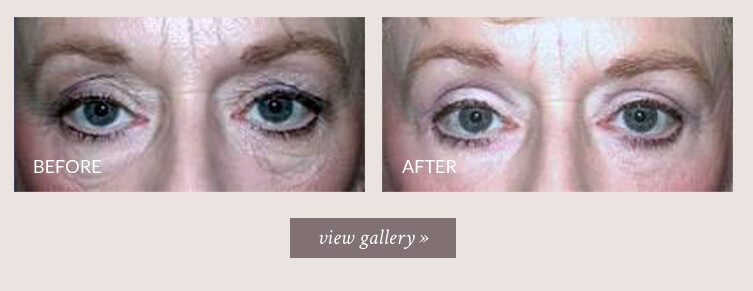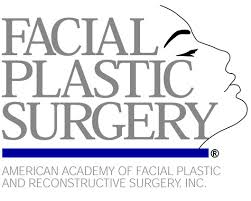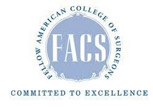Laser Resurfacing
What is a laser?
The term LASER originated as an acronym for 'Light Amplification by Stimulated Emission of Radiation'. A laser is a highly focused beam of pure light energy which may be used to carefully remove areas of sun-damaged skin, a process referred to as laser skin resurfacing. This procedure has revolutionized the field of cosmetic plastic surgery and treatment of aging skin over the past two decades. The main advantage of laser resurfacing over older resurfacing techniques (such as chemical peels and dermabrasion) is the precision with which the laser works. Our practice uses a number of different lasers for facial resurfacing. Lasers used for facial skin resurfacing are classified based on whether they are ablative or non-ablative . Ablative lasers remove the entire (100%) top layer of the skin in the area treated, whereas non-ablative lasers only remove a preset percentage of the area. Resurfacing lasers are also classified based on whether they are fueled by Erbium or CO2. The Fraxel laser, is a fractional Erbium resurfacing laser and offers the advantage of significantly shortened recovery times. The Derma K laser, which is a blend of ablative CO2 and ablative Erbium lasers, is capable of removing a layer of skin as thin as a fingerprint. This laser combines the advantages of Erbium and CO2 lasers into one exciting laser. Our practice also offers the Acupulse CO2 laser which offers both non-ablative and ablative CO2 laser resurfacing. CO2 lasers generally require a longer recovery period, but are also able to produce more dramatic results.
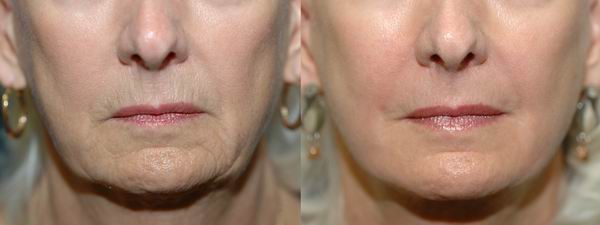
Before and After ablative CO2 Laser Resurfacing. * Individual results may vary.
Why does the skin wrinkle with aging?
Our skin is primarily made up of water, collagen, and other supporting materials such a hyaluronic acid and elastin. Normally, the collagen fibers are stacked on top of each other, much like bundles of spaghetti. These collagen fibers can glide against each other and have excellent elasticity. With aging, caused by sun damage, smoking, or passage of time, these collagen fibers reduce in number and the remaining ones become damaged and tangled. These damaged collagen fibers lack the elasticity and recoil of normal collagen and are 'stiffer'. This combination of collagen loss and stiffness of the remaining damaged collagen is the biological reason for wrinkling of aged skin.
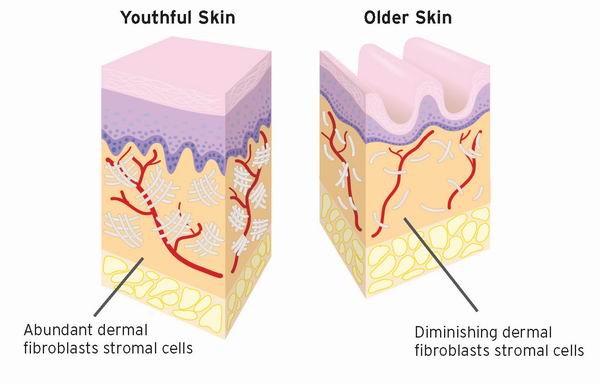
Older skin lacks the abundant healthy collagen of younger skin
How does laser resurfacing work?
Laser resurfacing works by peeling away the older, wrinkled, sun-damaged layer of skin, and allowing a new layer of skin to take over. As a new skin layer appears, it comes with a brand new layer of healthy collagen, which is why the appearance of wrinkles is dramatically improved. Because this is your own collagen, it will stay as part of your skin for years to come.
Laser resurfacing using the CO2 laser remains the 'gold standard' of all facial rejuvenation procedures aimed at improving skin quality. All other methods of skin rejuvenation are typically less effective than CO2 laser resurfacing in permanently improving wrinkles and skin quality.
What is ablative vs. non-ablative laser resurfacing?
Ablative laser resurfacing works by peeling the top layer of the skin and creating a wound that needs to heal as new skin is regenerated. Ablative lasers are Erbium and CO2. There are a number of non-ablative lasers with the most popular one being the Fraxel. Non-ablative lasers do not remove the top layer of the skin and thus there is no wound healing.
What is fractional laser resurfacing?
Fractional laser resurfacing works by treating only a fraction of the skin and therefore leaving some healthy skin behind for quicker recovery. Fractional resurfacing can be ablative (using Acupulse CO2 laser) or non-ablative (Fraxel). It has been shown that by fractional resurfacing, one can still get a nice amount of collagen production and improvement of skin wrinkles and age spots. There are a number of ablative fractional resurfacing technologies available on the market including the Acupulse (Active Fx, Deep Fx, Total Fx, Max Fx), Mixto, Profractional, and Pixel. We use a highly effective and proven method of fractional CO2 resurfacing using the Lumenis Acupulse laser platform used for Active Fx, Deep Fx, Total Fx, Max Fx, and Pigment Fx. Non-ablative fractional resurfacing is performed using the Fraxel laser.
What is Fraxel?
Fraxel is a non-ablative and fractional laser resurfacing with significantly reduced down-time. Fraxel can treat the skin very deeply to stimulate collagen yet it does not burn off or remove the top layer of the skin. Although one Fraxel treatment is not as effective as a single fully ablative CO2 laser resurfacing, Fraxel still results in a significant amount of collagen production and improvement of skin wrinkles and age spots. Multiple Fraxel treatments can produce results similar to a single fully ablative CO2 laser resurfacing. The Fraxel laser is gentle enough to treat the neck and chest as well as other areas on the body which are typically not suitable for treatment with fully ablative CO2 laser resurfacing. At Naficy Plastic Surgery & Rejuvenation Center we use the most advanced version of the Fraxel laser known as the Fraxel Restore Dual. It is called Dual because it uses a dual wavelength system of 1550 nm and 1927 nm, offering a significant boost in results over the older systems using just the 1550 nm.
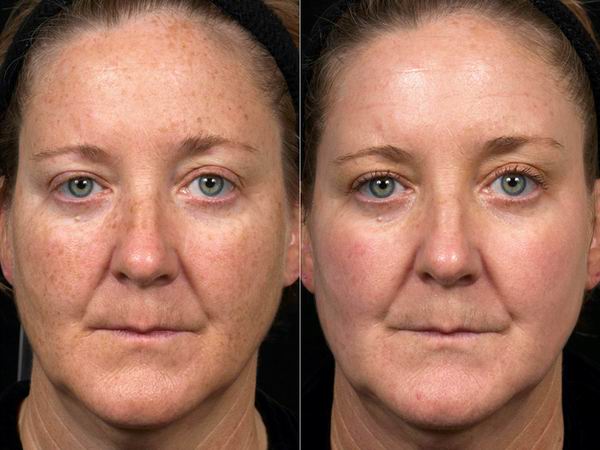
Before and After Fraxel Laser Treatment. * Individual results may vary.
Laser Resurfacing Photo Gallery
You may wish to browse through the gallery of representative before and after laser resurfacing pictures. Click on any of the thumbnails to enter the slide show. All procedures were performed by Dr. Sam Naficy and some patients may have had more than one procedure performed. The text accompanying the photos describes the details of the procedures performed.
* Individual results may vary.
Who is a good candidate for laser resurfacing?
The best candidates are individuals with fair to medium skin tone. Dark skinned individuals and those who tan regularly are not suitable candidates. Wrinkles and areas of irregular pigmentation caused by sun damage can be improved by this procedure. Acne scars will also be improved as a new layer of collagen is produced.
What type of anesthesia is used?
When laser resurfacing is done as a stand-alone procedure, it can typically be performed using topical and/or local anesthesia. When laser resurfacing is combined with other surgical procedures, it is typically performed under anesthesia.
What is the recovery like?
The treated skin will be replaced, for most patients, in 7 days with new skin. During this time it is important to keep the skin moist (with a healing ointment provided by our office) to facilitate healing. Treated areas of the skin will have a variable degree of pinkness that may take weeks to fully resolve, but may be typically covered with make-up in as early as 8-10 days for many patients. With fractional laser resurfacing the recovery time can be substantially less, as short as 4 days, for some patients, before make-up is worn, although individual healing times vary.
How do I know if I am a good candidate for surgery?
The best way to know of course is to come in for a consultation, but if you don't have time for that, the next best thing would be to submit a few photos to us which we can have reviewed by the surgeon and get back to you with a recommendation.
I am interested! What do I do next?
If you are considering Laser Resurfacing please fill out this Laser Inquiry Form. Dr. Naficy will tell you whether you are a suitable candidate for this procedure and inform you of the potential risks of the procedure. You will also receive cost and skin care information, and have a chance to view before and after photo albums of his patients who have undergone laser resurfacing procedures.


